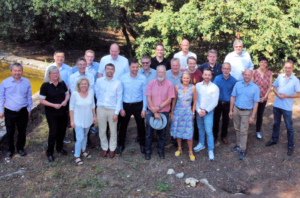IEA SHC: Attractive Solar Solutions for Urban and Landscape Planning
September 15, 2016
How can urban planners be convinced to consider solar energy technologies in municipality projects? This is the key challenge faced by the international group of researchers of Task 51, Solar Energy in Urban Planning. One way to attract interest from these planners is to present them with case studies of successfully implemented solar projects. So the members of Task 51 headed by Maria Wall, Professor at the Energy and Building Design department of Sweden’s Lund University, have collected around 40 solar case studies and are about to design a brochure for all of them. The authors distinguish between three types of studies: new urban areas, existing urban areas and landscapes.
Image: Task 51
Around one-third of the selected cases employ solar thermal, the others photovoltaic systems, according to Wall. “We’ve noticed that if urban planning focuses on solar thermal energy integration, often the project will also include solar electricity production. However, a case study which includes photovoltaics as the major technology usually doesn’t entail a solar water heating system,” Wall summed up the task work.
Each project brochure will include a cover page offering an overview of the project, key figures and pictures of the solar installation as well as of the newly constructed or renovated urban buildings. Two pages will summarise the challenges and decision-making strategies of the urban planning process. The central part of the booklet will validate the architectural quality of system integration by using the Quality-Site-Visibility approach, which was developed at the Solar Energy and Building Physics Laboratory of the Federal Institute of Technology Lausanne, LESO/EPFL, Switzerland. The following chart has been taken from the case study on the Canadian Drake Landing Solar Community, where 52 homes are connected to a borehole thermal energy storage which captures solar heat in summer for use in winter. The authors of the case study, Assistant Professor Caroline Hachem Vermette, and MS student Natalie Robertson, both University of Calgary, emphasise the fact that Drake Landing builders and land developers had been involved in the planning process from the beginning, which helped build confidence in the solar project. They also recommend that upcoming projects should have passive house design, so that a same-sized solar system can provide energy for a larger number of homes in the future.
 Architectural integration quality at Drake Landing Solar Community, Canada, set up in 2007
Architectural integration quality at Drake Landing Solar Community, Canada, set up in 2007Photo: CanmetEnergy, Natural Resources Canada; Chart: LESO/EPFL
In regard to landscape projects, the Task 51 researchers recommend further investigation into the potentially added value of having design professionals involved in the planning process on equal footing with technical experts. The aim is to create alternative design layouts in the form of drawings to show attractive and multi-purpose sites that will inspire local administrators to support the project. One case study is about the 18,600 m² collector field for district heating in Braedstrup, Denmark, designed by Simon Stendorf Sørensen from Danish consultancy PlanEnergi. The collector area is divided into segments of varying elevation by utilising the available terrain. The free-standing panels on grassland allow for the sheep to graze underneath, and even protected sensitive natural areas are located within the solar field (see photo and drawing below).
 Multi-purpose collector field in Braedstrup, Denmark. The wooden structure offers a resting place to locals who visit the area. The right-hand side shows a drawing from the planning process.
Multi-purpose collector field in Braedstrup, Denmark. The wooden structure offers a resting place to locals who visit the area. The right-hand side shows a drawing from the planning process. Photo: Braedstrup Fjernvarme, Drawing: Horsens Municipality
The work on the Task 51 case studies is led by Dr. Gabriele Lobaccaro and Dr. Carmel Lindkvist at the Norwegian University of Science and Technology, NTNU. The publication of the case studies at the end of the year will be followed by a lessons-learned report. In addition, all case study brochures will be available on the Task 51 website as soon as they are ready. The next Task 51 meeting, which includes a workshop on software planning tools, is going to be held in Berlin between 26 and 29 September 2016.
More information:


